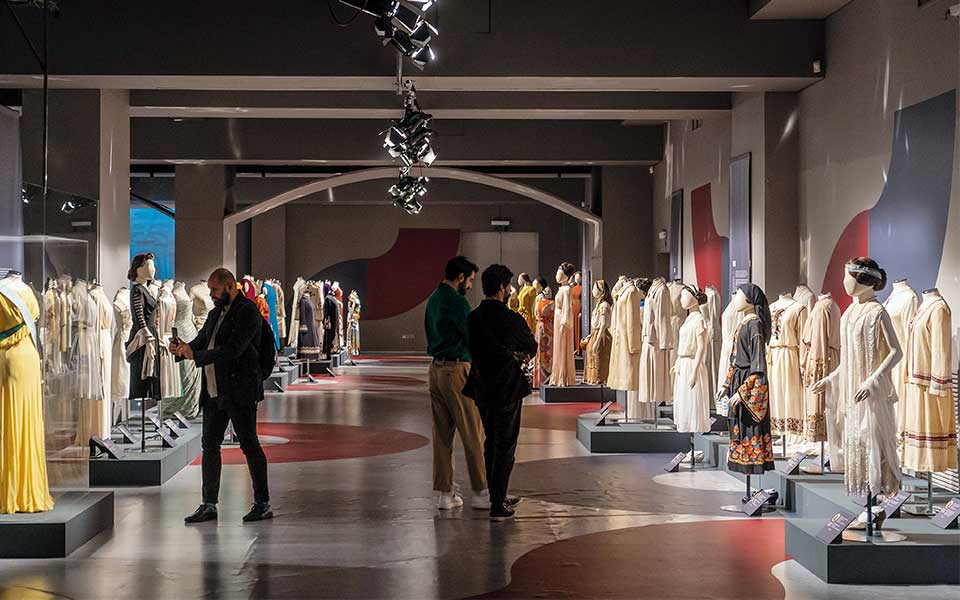The first thing that catches my eye at the exhibition “Greek Fashion: 100 Inspirational and Creative Years” at the Hellenic Cosmos Cultural Center is a poster featuring a piece by the well-known painter Nikos Engonopoulos, one of the country’s key figures of the surrealist movement. In it, a beautiful woman poses in a dress designed by Yiannis Evangelides, with evident influence from traditional Attic bridal gowns; the windmills in the background tell us she’s on Mykonos.
The year is 1938, and the occasion is the country’s first state fashion competition, featuring dresses inspired by folk culture. Engonopoulos had been hired by the magazine La Mode Grecque to produce illustrations of this event, which signaled the debut of Greek fashion inspired by the country’s ancient culture and of its modest entrance onto the global runway.
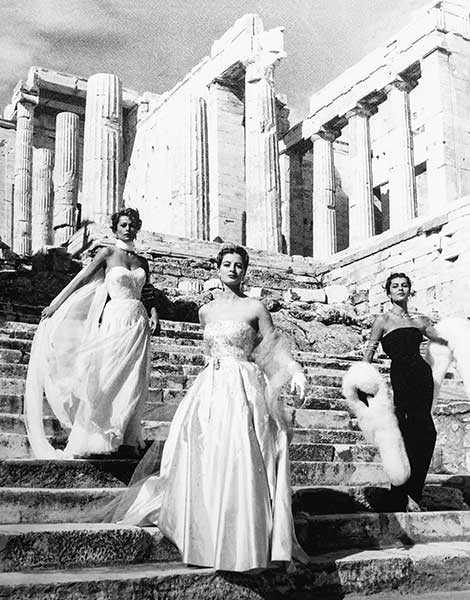
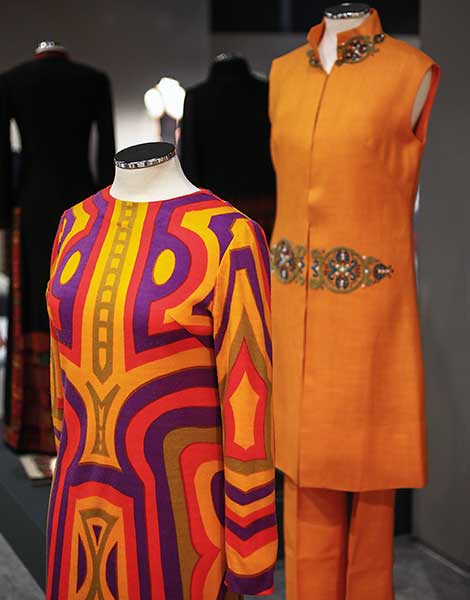
© Nikos Kokkalias
A decade-by-decade intro
My tour begins in a foyer area, with an introduction to Greek fashion from the show’s curator, Nikos Saridakis. Pieces representing each decade are on display, starting with a clay-red dress of mercerized cotton embellished with embroidery. The long pearl necklace, the period shoes and the characteristic hairstyle on the mannequin transport me to the 1920s, and I can almost hear the happy din of a dance hall where elegant young women move to the rhythm of the Charleston and wave long, thin cigarette holders.
The brief decade-by-decade introduction ends with a modern piece by the late Sophia Kokosalaki, the talented Greek designer who passed away at the age of 46 earlier this year. Her unique point of view, elegant style and technical sophistication are encapsulated in a timeless white dress, a piece that could just as well have been made thousands of years ago.
Kokosalaki was a modern designer who showcased her “Greekness” in much of her work. It was her example that Jean Paul Gaultier, Karl Lagerfeld and even Dolce & Gabbana followed, creating entire collections inspired by ancient Greece and local costumes from the 18th and 19th centuries.
On the other side of the room, photographic panels show where designers found their inspiration. Influences range from the Minoan, Mycenean, Archaic, Classical and Hellenistic periods through to the Byzantine and Ottoman eras; the War of Independence is there, too, as is the 20th century, when Greek fashion began to look to the West, and the present century as well.
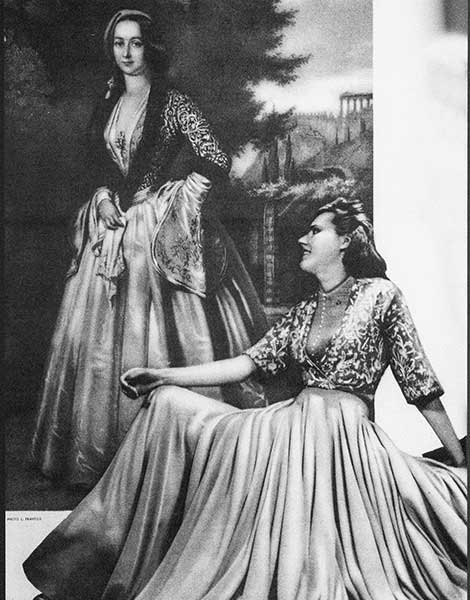
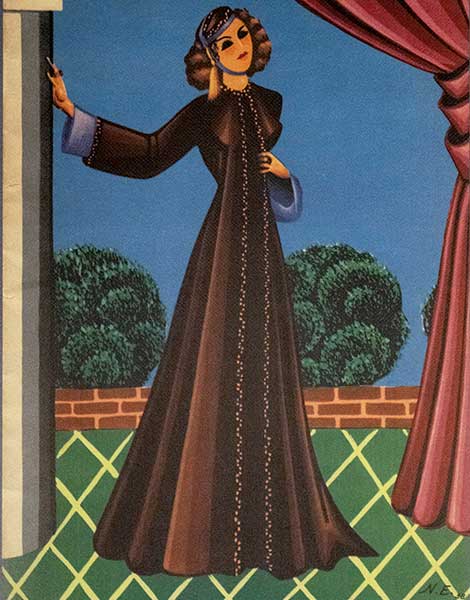
The story of historical Greek designs in fashion starts when archaeological excavations brought ancient Greece to the spotlight and Greek influences spread across Europe and all the way to the United States. In 1903, dancer and choreographer Isadora Duncan took to wearing short white chitons and moved to Athens. Pleats and drapery featured prominently in the clothing of French couturiers Paul Poiret, Madeleine Vionnet and Madame Grès, as well as Spain’s Mariano Fortuny.
The trend then returned to Greece in the form of a counter-loan. Greece already boasted a couture scene, but this was almost exclusively limited to the palace and a few wealthy individuals, as the masses continued to wear traditional dress.
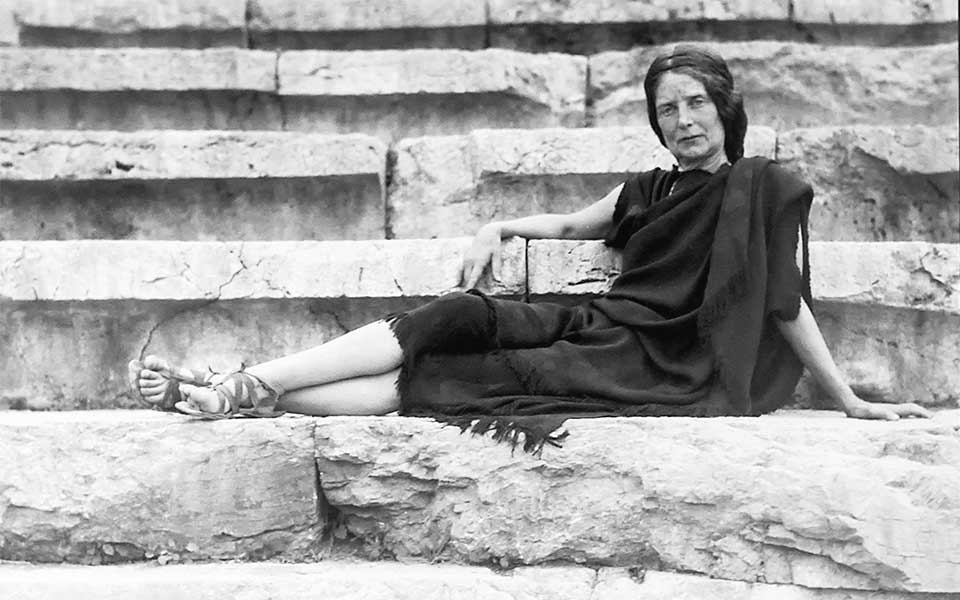
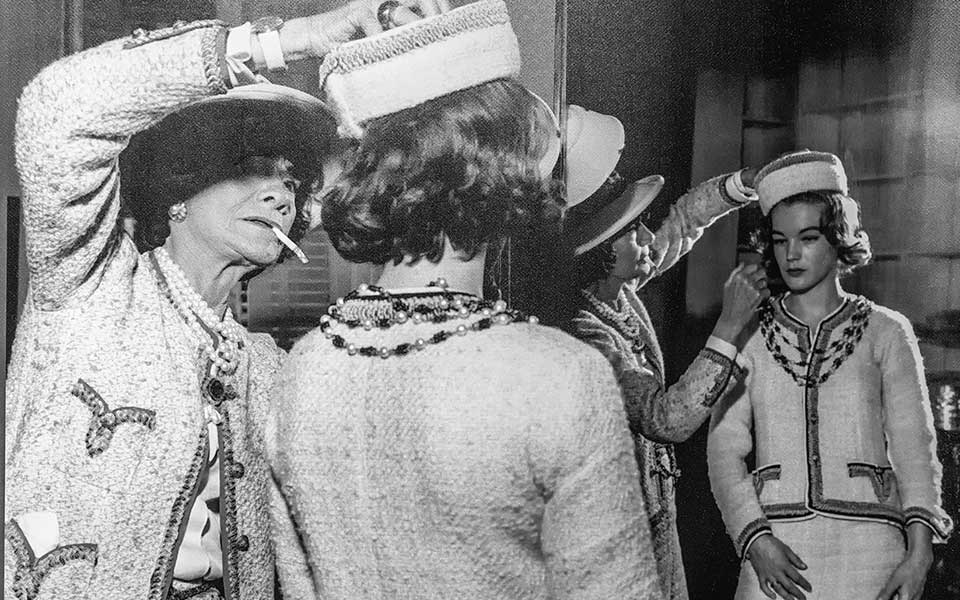
© G.Botti/Getty Images/Ideal Image
The ongoing Hellenic Cosmos exhibition, the first of its kind in Greece, is wide-ranging, a fact that is evident from the moment that you step into the main display area and catch sight of the 137 garments comprising the show and covering a century of creative output.
This is, however, just a small selection from the comprehensive fashion collection of the “Vasileios Papantoniou Peloponnesian Folklore Foundation” (PFF). Made up of 23,000 pieces, it is the lifework of PFF director Ioanna Papantoniou, a treasure that’s hidden away in various buildings in the historic seaside town of Nafplio, still waiting for the right conditions so it can be brought to light in its entirety.
The exhibition is designed to show the evolution of fashion in Greece over the past century. Pieces by famous Greek designers who enjoyed international acclaim, such as Evangelides and Jean Dessès, are showcased beside the work of humble, anonymous dressmakers. Tourist-targeted garments from the ‘60s and ‘70s are juxtaposed with the sophisticated creations of well-known designers.
What unites them, however, is the fact that they were all inspired by different periods and aspects of Greek culture.
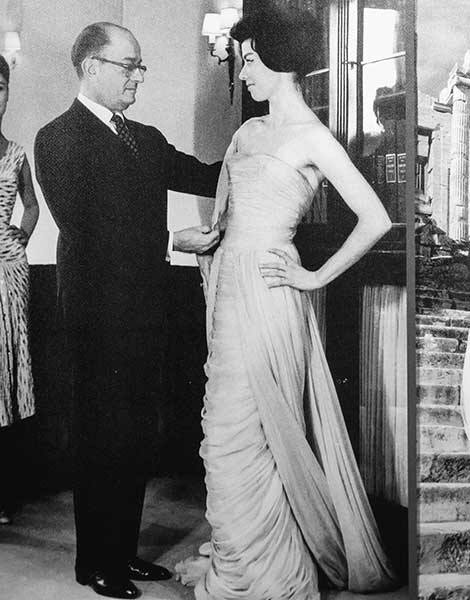
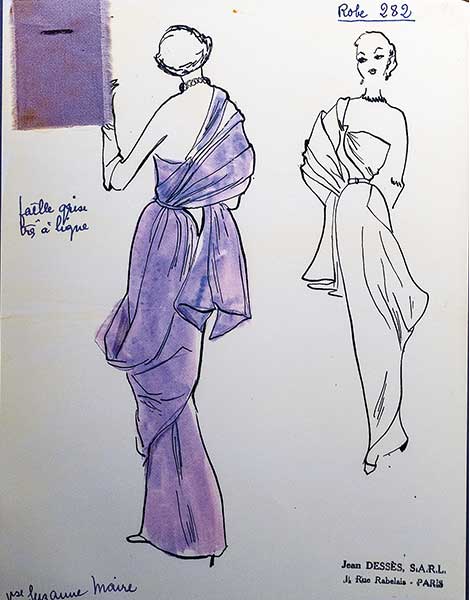
Over the next few years, ancient and folk culture began to coexist in fresh trends that were adopted by the innovative, educated and dynamic women of the emergent middle class of the 1930s. World War II interrupted this trend, instead spurring the repurposing, recycling and redesigning of clothing. The embroidered pieces of traditional costumes were cut out and put to one side for future use, while the remaining fabric was sewn into something new for daily wear.
The end of the war brought the New Look that was introduced to Europe by Dior. In Greece, new designers joined the ranks of the old and together they marched into the 1950s to the tune of Europeanization and the dictates of tourism. “Island” fashion became all the rage, while drapes, pleats and folds reminiscent of the Caryatids and the statues of Athena Nike found favor, too. Old embroidery pieces were taken out of drawers and added as decorative details in new creations.
This trend carried Greek fashion into the 1960s, when Yannis Tseklenis rocked the domestic scene by giving Greek pret-a-porter international resonance, just as another revolution was taking place abroad. This was the advent of the miniskirt, an event that signaled a complete break with the forms of the past. Greek-inspired fashion’s international heyday lasted through the ‘70s but began to wane in the ‘80s, when punk and disco inspired a wave of new designers and the elements of “Greekness” all but vanished. Greek culture as a source of inspiration didn’t return until the start of the new century.
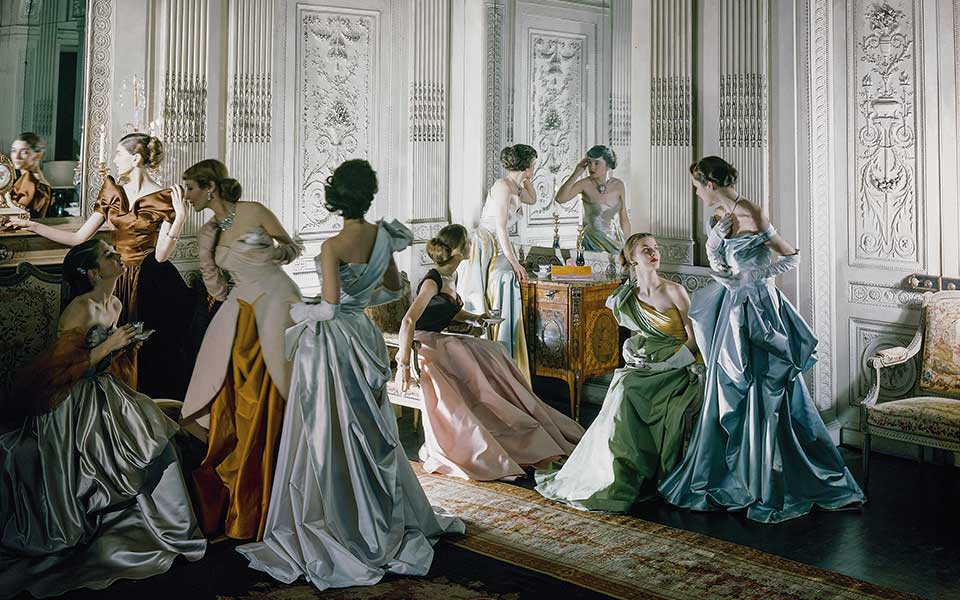
© Cecil Beaton/Getty Images/Ideal Image
playing with time
As I walk through the main part of the exhibition, which is also arranged chronologically, I note all the historical references, the different ways they are expressed and how they are applied, at times overtly and at others more discreetly, in the geometry of a garment or in its embellishments. (Different textiles, threads, dyes, embroideries and knits are also celebrated in the exhibition, as are textures and color palettes.) More modern influences occasionally overshadow initial concepts, though often outfits accurately reflect aspects of the era that inspired them and a few are, in fact, faithful copies of much earlier work.
It’s a fun game musing on the different eras and places represented by these garments and wondering who wore them and for what occasion. Who, for instance, was the woman in the rural town of Sparti in 1926 who wore that impressive muslin gown covered in beadwork? Was the loom-woven coat worn in 1930 by Greece’s very first tour guide, Marika Veloudiou, comfortable? And that cutting-edge off-white satin dress with embroidered floral details on the back, what kind of impression did that make in 1940?
If I were a tourist, I would certainly never buy that 1950 linen dress with the ancient monuments on the shoulders and the hem! How was Fotini Livanou received by New York’s high society in 1956 when she appeared in the strapless Evangelides gown with the hand-stitched flowers? That 1960 black woolen Tsopanellis ensemble embroidered with cord is simply a masterpiece, as is that jacket onto which Katerina Giannakea embroidered landscapes, rather than just painting them.
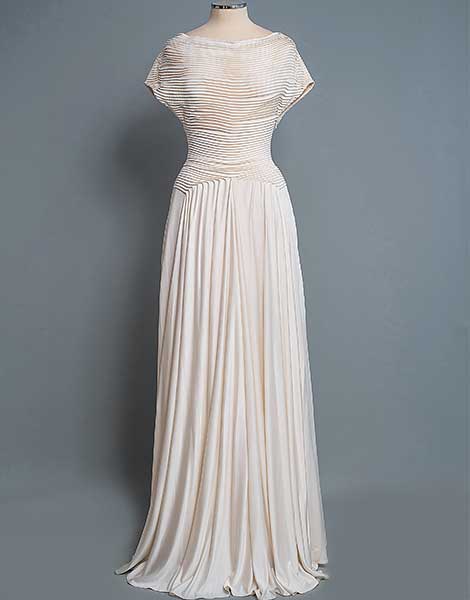
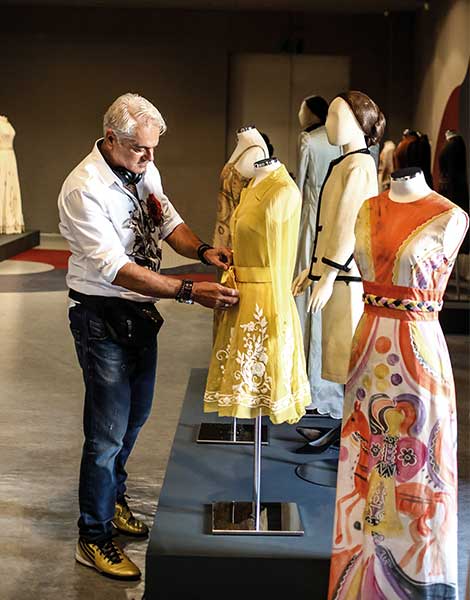
© Nikos Kokkalias
The guest star of the show is a piece that is being shown for the first time. It’s a dress by Dessès, known as “the king of muslin,” inspired by the Caryatids. The pale and egg yolk-yellow silk gown was worn by a former Greek queen, Anne-Marie, at a pre-wedding reception for Princess Beatrix in Amsterdam in March 1966. It was recently discovered in a cupboard in the former royal palace in Tatoi, north of Athens, and was restored by the competent department of the Culture Ministry.
As I look around, I ask myself which of the exhibits I might wear today and am surprised to find there are quite a few I’d be happy to add to my wardrobe. At a time when it feels that styles have become humdrum and homogenous, the wealth on display in this show is a feast of diversity.
The exhibition ends with the blue linen “Acropolis” skirt and the “Altis” dark blue chiffon blouse from Zeus & Dione’s 2020 Winter collection. This forward-thinking fashion brand creates pieces that are inspired by Greece and made in Greece with Greek materials, though with a modern take and designs. Its success is indicative of the heights Greek fashion has scaled in the past 100 years.

